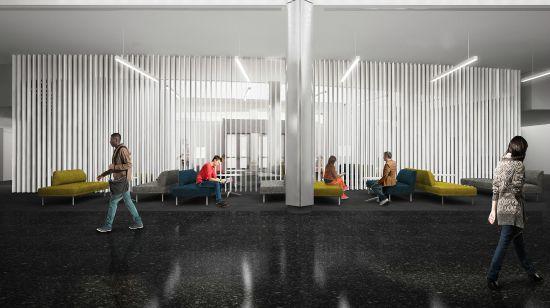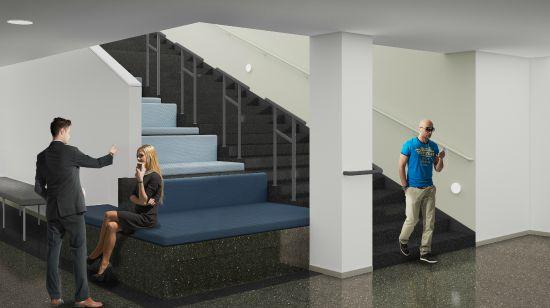Pardon Our Appearance…A Jerome Greene Hall Transformation Is Underway!
The Reimagined Space Will Feature Flexible Seating Arrangements and a More Collaborative and Welcoming Feel
New York, August 18, 2015—Uplifting and
“Columbia Law School is set apart by a diverse and eclectic student body, and our faculty is boldly pursuing research that has the capacity to transform the law and shape our society,” said Gillian Lester, Dean and the Lucy G. Moses Professor of Law. “But comfortable and inviting shared spaces also enrich academic life. The school would benefit from more space that enables students and faculty to engage easily outside the classroom. That’s what these renovations have been designed to address.”
A committee of faculty, students, and administrators has been overseeing the interior renovation, which will foster opportunities for increased collaboration throughout JGH. The project has been shepherded by Dean Lester, who has made building a stronger community one of her primary areas of focus since joining the Law School in January.
“Many people have put much thought and effort into redesigning the space so that it reflects the warmth and academic vitality of the Law School, and more importantly, of our student body,” said Dean of Graduate Legal Studies Sylvia T. Polo, who served on the committee. “While renovation will continue for a bit longer, we are all confident that the effects on community life at the Law School will be enduring and a reflection of all of the amazing things that happen here.”
The design and construction will include a major new focal point in the JGH entrance, including a unique installation that adds depth and dimension by reflecting the space’s natural light and complementing its high ceilings.
|
A digital rendering of the updated lobby of Jerome Greene Hall, which will feature new furniture and a variety of seating arrangements for students. Courtesy of Studio Joseph. |
“We want people to experience an uplifting and expansive feeling when they walk in,” said Joseph, principal at Studio Joseph, an award-winning New York-based architecture firm specializing in diverse institutional, cultural, and residential projects. Joseph is the architect behind such projects as the Rockefeller University Pedestrian Bridge and Starlight, the light sculpture in the entry space of the Museum of the City of New York.
Prioritizing Student Space
One of the central features of Jerome Greene Hall’s updated lobby will be new furniture set in a variety of configurations, including group workspaces, comfortable couches, and high tables that accommodate stools or standing. Some of the renovations are part of an “active design," which uses simple changes to influence the way people behave in a space.
Other elements of the reimagined lobby include:
- large graphic murals featuring views of Manhattan and text from the U.S. Constitution,
- stadium seating on the Skadden Stairs where students can hang out or meet friends between classes or events,
and tables in the east corridor that foster group engagement and activity.
| The Skadden Stairs have been redesigned with stadium seating where students can gather to hang out or wait for friends between classes or events. Courtesy of Studio Joseph. |
The new and improved JGH lobby will feel more modern and coherent, said Professor Alex Raskolnikov, a member of the committee overseeing the renovations. Other members include: Professors Elizabeth S. Scott and Robert E. Scott, Associate Dean of Administration and Finance Ed Moroni, Dean of Students Michelle Greenberg-Kobrin ’99, Chief Information Officer Frantz Merine, Allen R. Davis ’16, Ana S. Kowalenko ’15 LL.M., and Columbia University Capital Project Manager Ira Pinkus.
Strengthened Community
The changes to the first floor of Jerome Greene Hall—which was originally built in 1961—aren’t the only transformations happening across campus in the effort to encourage community building. Columbia Law School’s pathbreaking clinics have been brought together in newly renovated space in JGH. All clinics can now conduct their business in professional offices that support collaboration among students, faculty, and supervising attorneys and also provide a more private and welcoming environment for clients.
"For almost half a century, Columbia Law School has been an innovative leader in clinical legal education," said Professor Carol B. Liebman, who teaches in the Law School’s Mediation Clinic with Professor Alexandra Carter ’03. "Our clinical professors have been national pioneers in developing a rigorous pedagogical methodology, while working with committed students to address critical social justice problems. Our new space will allow students to continue this proud tradition in a state-of-the-art legal office as they work on such issues as mass incarceration, children’s rights, gender and sexuality, environmental harms, community development, human rights, immigration, and conflict resolution."
Several administrative offices also changed locations over the summer as part of an effort to make accessing the Law School’s many resources easier for students. Career Services and Social Justice Initiatives have relocated to Big Warren, joining the offices of Admissions, Graduate Legal Studies, Financial Aid, and the Registrar. To make room in Big Warren, Human Resources and the Business Office were relocated to Little Warren, and the Office of Communications and Public Affairs is now in Jerome Greene Annex. Next summer, a renovation is planned for Case Lounge.
“I want to reignite at Columbia Law School a strong sense of collective mission and community, not only among our faculty, but also among the staff, students, and alumni,” Dean Lester said. “A strong and inclusive Law School community nurtures a vibrant learning environment, and leads to an enduring sense of Columbia pride.”

